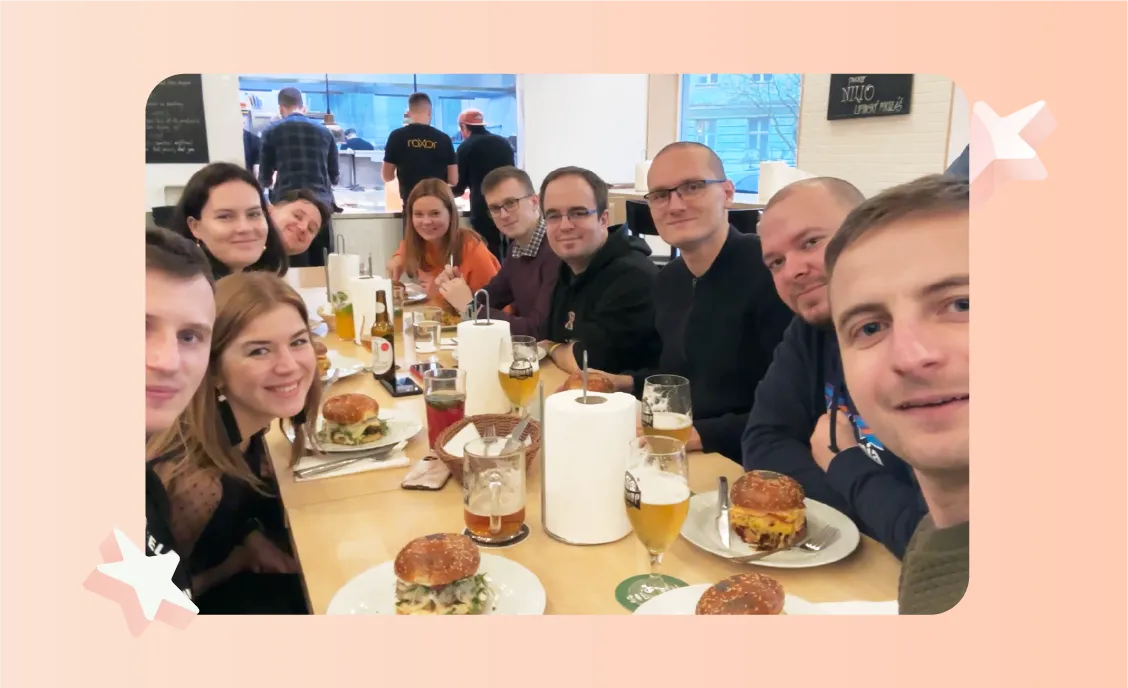A strong customer service team culture is the direct result of trusting, engaged employees.
Team culture has become a bit of a buzzphrase over the past few years, but for good reason. People spend a lot of time at work and walking into a nightmare environment with a team you don’t really jive with can take its toll.
On the other hand, being part of a team that fosters a positive attitude and believes in the company’s vision and goals, can be an amazing experience.
But a positive, motivated, goal-chasing team doesn’t just form overnight. It takes deliberate action, honesty, and people that care enough to make it work.
If you’re a team leader who knows their team has what it takes but is just lacking a little direction, here are a few steps you can take to begin creating a positive, growth-driven customer service team culture.
We also share great insights from our beloved colleague, Katarina Javorcikova, on how to build a strong and long-lasting team culture within your company.
Start your day
with great
quality
content
Gratitude And Attitude
Maybe you read that headline and rolled your eyes a bit. But let me stop you there. Gratitude and a positive attitude don’t mean your team needs to walk around with a smile plastered on their face, praising each other 24/7 and having collective gratitude journaling sessions (but if that’s your thing, more power to you).

It only means that it’s ok to loosen up and step back from the high-stress, competitive, and thankless environment that so many workplaces consist of. Sure, it might be getting things done, but are your people happy?
Psychologists Adam Grant and Francesca Gino conducted a series of experiments and discovered that receiving a simple “thank you” from a supervisor boosted employees’ self-worth and self-efficacy. And the cherry on top? These experiments also revealed gratitude has a spillover effect and people become more trusting and are more likely to help each other out in that type of environment.
It could be as simple as telling someone you appreciate their work or complimenting something they’ve recently accomplished. Showing a little gratitude for your team can go a long way – people always want to know that they’re valued.
But be aware not everyone likes to be thanked in the same way. Yes, some people love public recognition and praise or gifts. But for others, those acts of gratitude could make them uncomfortable. Customize how you show your gratitude to each individual. Which means you actually have to get to know them on a more personal level.
On a larger scale, employee benefits totally count as a gesture of appreciation. Here are a few of the most popular employee benefits:
- Flexible or remote work schedule
- Healthcare
- A generous amount of vacation time (especially if it’s paid)
- Stock options
- 401K, pension, and/or retirement plans
- Team trips
- Employee education and development stipend
- Gym memberships
- Free meals
Whichever direction you choose to take, just remember to be genuine in your efforts. An office party is no substitution for true employee appreciation. Just like you can’t buy love, you can’t buy employee trust or engagement. No amount of free coffee, ping pong or team trips can create that.
Keep People Engaged
A strong customer service team culture is the direct result of trusting, engaged employees. To reach this level of team engagement, there need to be clear expectations and communication from team leaders.
If employees can’t answer questions like, “What exactly are you trying to achieve and why?” or they don’t understand what purpose they serve on the team and how they can contribute, it’s time to get everyone on the same page.
As CX specialist Jeff Toister put it in his interview with Zendesk, engagement is when employees understand what a company is all about and decide they’re passionate about that purpose too. It’s not that everything is rainbows and sunshine every day because that’s unrealistic. Instead, it’s about having employees that come to work every day to work towards the same goal and have the desire to improve the company’s overall bottom line.
Additionally, this means that as a leader, being receptive to feedback, questions, and ideas from others is important. Otherwise, it’s more like barking orders than setting expectations.
Encourage people to work together and also contribute their own individual skill sets and knowledge to create an overall stronger team. Give your team ownership over whatever goals you’re attempting to achieve and trust that they can handle their mission.
Does Your Team See The Vision?
On that note, finding people who fit with the culture your company is building, see the vision and want to be a part of it doesn’t just happen without intention. It requires hiring the right people and assessing your current team culture.
Your company vision and mission are the statements that attract the right (or wrong) people to your business on both a customer and employee level. If it’s disjointed that could mean not everyone on your team is aligned with the business, which can actually be quite costly in the long run.

Examining your current culture and the type of people it has attracted can be eye-opening. Take a look at the performance you see from your team.
- How do they handle challenges and how often do they pop up them?
- Is your team growing or are things stagnant?
- Do people seem to be excited about their work or are they just there because they need the money?
Those are just a few of the probing questions to understand where your customer service team culture stands. You could also choose to have deliberate conversations around culture with your employees. Or send out surveys to better understand people while allowing them to remain anonymous.
If things are off and people aren’t ultimately aligned with your business and its vision you may notice there are people with toxic, negative attitudes and who don’t really care about their job or the team. Even worse, employees you thought were happy just suddenly quit.
Having open conversations about the overall company vision and thoroughly vetting new hires can save the company from high turnover and toxic, unengaged teammates.
Keep It Real
Pulling back the layers of your team and how they work requires transparency and honesty on both sides. Your team has dedicated their working days to you and the overall company dream, it’s only fair to be real with them.
Not only does enforcing honesty as a policy avoid general confusion but it makes leadership and management easier to trust. Secrets and avoidance only make room for false assumptions, rumors, anxiety, and an overall negative vibe.
Becoming disconnected from your team because you’re at a leadership level can make people feel separated. It creates an us vs. them environment that’s the very opposite of a strong customer service team culture.
Take notes from a page in Kayako’s team handbook: “We work hard to ensure we keep our internal information flowing clearly and smoothly through all-hands meetings, lunch learns, and internal newsletters, preferring open Slack channels to direct messages. Encourage team leads to use regular 1:1’s with their teams. Or take it further, our PeopleOps teams ensure everyone has a sounding board outside of their team or their immediate manager to voice their issues or concerns.”
Get in touch with what’s going on behind the scenes in a genuine way. It doesn’t need to be formal or serious but have conversations with people. Get to know them and their work and learn to understand the people on your team – it works wonders at breaking down barriers.
Take Ownership
As a team leader, you must realize that it’s on you to do just that – lead the way. Take ownership of the customer service team culture you want to create and then put that vision to work. It’s easy to get caught up in daily to-dos and deadlines but making sure your people are taken care of and can count on you as well as each other to work towards common goals will be a lot more satisfying.
Nicereply’s Team Culture by Katka
Katarina Javorcikova cares about the happiness of our clients at Nicereply, as a Head of Customer Success. We asked her how she perceives the importance of team culture. Her smart tips will help you keep your relationships at the workplace healthy and strong.
“When defining the team culture, every team leader should ask this question: What it feels like to work on my team? By putting themselves in the shoes of the team members, they are able to define the behavior that drives high performance and satisfaction for the whole team.”
We can’t describe the culture in one word. Team culture is how team members do their job, how they show up, what energy and values they bring to the team, and how they treat each other.
Especially in Customer Support, agents are faced with different types of issues, clients, challenges, behavior, and emotions day in and day out. A supportive culture can prevent burnout, help agents overcome thought days, support their professional and personal development and enjoy the daily work.
I recommend identifying the key behaviors that create a culture inside your team. Key behaviors people want to live, experience, and maintain daily.
Questions that help you identify the key behaviors
- What it feels like to work on my team?
- Do we give and receive feedback? What do people think of feedback?
- How do I want to treat my team members?
- How do I support the mental health of agents?
- How do we support each other? Do we share our daily experiences and listen to each other?
- How do I want to level up agents’ skills?
- How do agents perceive the daily challenges? Do they see challenges as a path to progress?
- How do you approach failure? Do agents feel safe making a mistake?
- How do you navigate conflicts?
With more and more support teams working remotely, leaders should think about how to build and maintain remote team culture.
From my experience, the backbone of the remote culture is transparent communication. Moreover, people should feel visible and part of the team. Furthermore, I would invest in creating a sense of community and belonging because agents feel engaged and connected to something.
To give you one tip on how to learn to communicate effectively, our team participated in the workshop about critical thinking and argumentative techniques. Compared to typical communication training, we learned how to offer credible facts and sufficient evidence to support the worthiness of our argument. After this training, our team meetings became more productive.
Last but not least, the best way to contribute to camaraderie in the team is merch (hoodies, cups, t-shirts, stickers, caps, etc.) Attending an all-hands meeting in a team t-shirt is fun.













